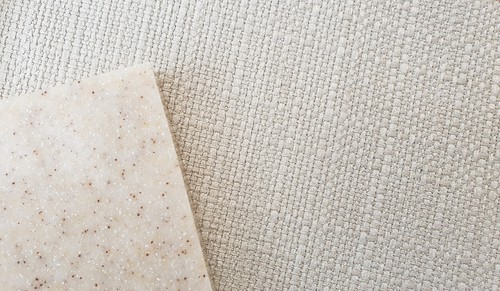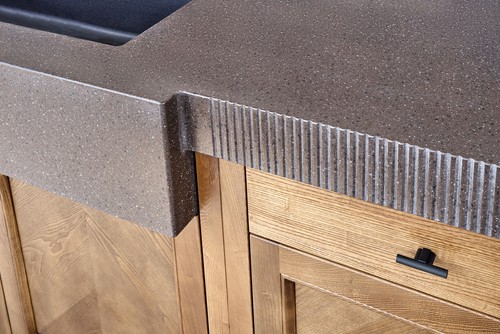
Small Kitchen Design: Making the Most of Limited Space
October 5, 2023
Budget-Friendly Kitchen Cabinet Makeovers
November 28, 2023How to Repair Scratches and Minor Damage on Solid Surface

How to Repair Scratches and Minor Damage on Solid Surface
How to Repair Scratches and Minor Damage on Solid Surface? Solid surface materials have gained popularity for their remarkable durability and aesthetic appeal, making them a sought-after choice for countertops, tabletops, and various surfaces in homes and commercial spaces.
However, as with any material, wear and tear are inevitable. This guide focuses on the essential steps to repair scratches and minor damages on solid surfaces, helping you restore their pristine condition.
Characteristics of Solid Surface Materials
Common Types of Solid Surface Materials
Solid surface materials encompass a range of brands and compositions, with Corian and quartz being two well-known examples. Understanding the specific type of solid surface in your space is crucial for effective repair.
Physical Properties
Solid surface materials are prized for their stain resistance, toughness, and ability to withstand daily use. However, their smooth and glossy surfaces are susceptible to scratches and minor damages, which can compromise their aesthetics.
Susceptibility to Scratches and Minor Damage
While solid surface materials are durable, they are not impervious to scratches and minor damages. Daily activities, contact with sharp objects, and accidental impacts can leave their mark over time.
Tools and Supplies You Will Need
Before embarking on a repair project, gather the necessary tools and supplies:
- Sandpaper of Varying Grit Sizes: Different grit sizes are essential for various stages of the repair process, from initial sanding to fine polishing.
- Rubbing Compound: A rubbing compound helps remove scratches and imperfections from the solid surface.
- Microfiber Cloths: Soft microfiber cloths are ideal for cleaning and polishing.
- Plastic Spatula and Filler Material: These are required for repairing deeper gouges and chips.
Types of Minor Damages and Scratches
Understanding the nature of the damage is essential for selecting the appropriate repair method:
Surface-Level Scratches
Surface-level scratches are minor abrasions on the solid surface. They are usually shallow and affect only the top layer of the material.
Deeper Gouges and Chips
Deeper gouges and chips penetrate the surface of the solid material. They are more noticeable and require additional steps to repair.
Stain and Heat Marks
Stains and heat marks are discolorations that can mar the appearance of solid surface materials. They often result from exposure to hot cookware or spilled substances.
Steps to Repair Surface-Level Scratches

Repairing surface-level scratches can be relatively straightforward:
- Cleaning the Damaged Area: Clean the damaged area thoroughly to remove any dirt or debris.
- Light Sanding Techniques: Use sandpaper with a low grit size to gently sand the scratched area. Gradually progress to higher grit sizes to refine the surface.
- Applying Rubbing Compound and Buffing: Apply a rubbing compound to the sanded area and buff it in a circular motion. This will help remove fine scratches and restore the surface’s shine.
- Final Polishing Steps: Finish the repair by polishing the area with a clean microfiber cloth. This will further enhance the glossy finish.
Repairing Deeper Gouges and Chips
Addressing deeper gouges and chips requires additional steps:
- Preparing the Damaged Area: Clean the damaged area and ensure it is free from loose debris.
- Selecting the Right Filler Material: Choose a suitable filler material that matches the color and composition of the solid surface. Apply the filler to the gouge or chip.
- Applying and Smoothing the Filler: Use a plastic spatula to apply the filler evenly to the damaged area. Smooth it out to match the surrounding surface.
- Sanding and Polishing to Blend: After the filler has dried, use sandpaper to sand the repaired area gently. Gradually progress to higher grit sizes and finish with polishing to blend the repair seamlessly.
Addressing Stain and Heat Marks
To tackle stains and heat marks:
- Identification of Stain and Heat Marks: Identify the type of mark and its source to determine the appropriate cleaning method.
- Use of Specialized Cleaning Agents: Depending on the mark, use specialized cleaning agents designed for solid surface materials. Follow the manufacturer’s instructions for safe and effective cleaning.
- Buffing and Polishing Techniques for Heat Marks: For heat marks, gently buff the affected area using a rubbing compound or a specialized solid surface cleaner. This can help restore the surface’s original appearance.
Precautions and Safety Measures
When conducting repairs on solid surface materials, prioritize safety:
- Personal Protective Equipment (PPE): Wear appropriate PPE, including safety goggles and gloves, to protect yourself during the repair process.
- Proper Ventilation: Ensure proper ventilation in the repair area to disperse fumes from cleaning agents and compounds.
Professional Help vs. DIY: When to Call the Experts

Deciding whether to attempt repairs yourself or seek professional help depends on several factors:
- Assessing the Level of Damage: Evaluate the extent of the damage. While surface-level scratches can often be DIY-repaired, deeper gouges and extensive damage may require professional intervention.
- Cost Considerations: Consider the cost of materials and tools versus hiring a professional. In some cases, professional repair may be more cost-effective.
- Time and Skill Requirements: Assess your skill level and the time you can dedicate to the repair project. Professional repair may save you time and ensure a high-quality result.
FAQ (Frequently Asked Questions)
Can All Types of Solid Surface Materials Be Repaired at Home?
Most types of solid surface materials can be repaired at home, but the specific repair methods may vary depending on the material. Always consult the manufacturer’s guidelines for your particular solid surface.
How Do I Choose the Correct Grit Size for Sanding?
Selecting the correct grit size for sanding depends on the depth of the damage. Start with a lower grit size for deeper damage and progress to larger grit sizes for fine polishing.
What Are the Best Cleaning Agents for Stain Removal?
The best cleaning agents for stain removal on solid surface materials are those recommended by the material’s manufacturer. These products are formulated to effectively remove stains without damaging the surface.
Is It Possible to Completely Restore the Original Appearance?
In many cases, it is possible to restore the original appearance of solid surface materials with proper repair techniques. However, deep or extensive damage may result in some visual variation.
How Often Should I Perform Minor Repair and Maintenance?
Perform minor repairs and maintenance as needed. Regular cleaning and preventive measures can help minimize the need for extensive repairs.
Myths and Misconceptions

Dispelling common myths and misconceptions about solid surface repair:
“Solid Surface Materials Are Indestructible”
While solid surface materials are durable, they are not indestructible. They can be scratched and damaged over time, although repairs are often possible.
“Any Scratch or Damage Requires Professional Intervention”
Many minor scratches and damages can be repaired at home with the right tools and techniques. Professional intervention is typically reserved for extensive or complex damage.
“Regular Household Cleaning Agents Are Sufficient for Stain Removal”
While some stains can be removed with household cleaning agents, it’s essential to use specialized cleaning agents recommended by the manufacturer for the best results.
Maintenance Tips for Longevity
To ensure the longevity of your solid surface surfaces:
- Perform regular cleaning and polishing to maintain their shine and appearance.
- Implement protective measures to avoid scratches and chips, such as using cutting boards and trivets.
- Consider periodic professional servicing to address any major issues and maintain the material’s integrity.
How to Repair Scratches and Minor Damage on Solid Surface – Conclusion

In conclusion, repairing scratches and minor damages on solid surface surfaces is a manageable task that can help maintain the beauty and durability of these materials.
By understanding the characteristics of your solid surface, gathering the right tools, and following proper repair techniques, you can effectively restore their pristine condition.
For further information on solid surface care and maintenance, explore our related articles on preserving the longevity of your surfaces!
Are you seeking a professional and reliable kitchen cabinet installation service in Singapore? Contact us today!



